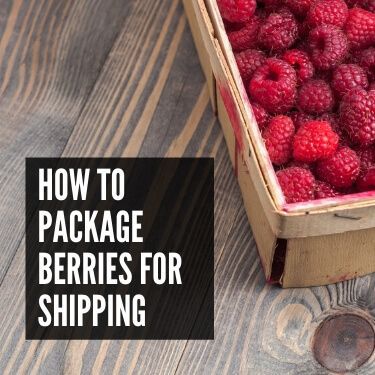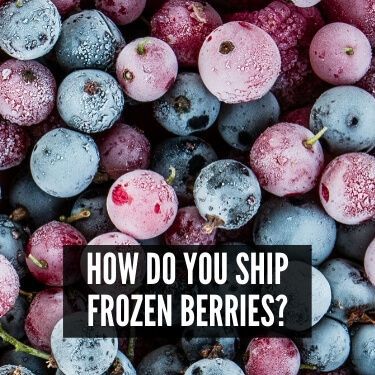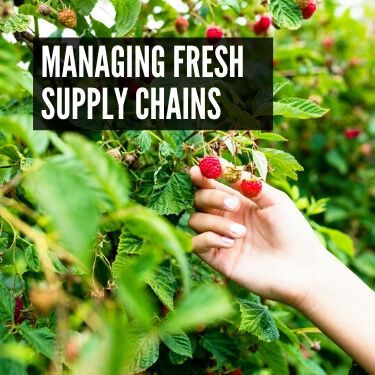If you’re new to shipping your produce around the United States and selling to interstate customers, then you might not know how to ship berries correctly. Mistakes could result in you losing your shipment in any number of ways, so you should educate yourself on the best practices before you get started. In fact, you should do your research long before the harvest season is upon you, so you will have plenty of time to prepare for the process. The last thing you need is to lose an entire truckload of delicate, valuable berries just because you didn’t know what you were doing.
The question of how to ship berries doesn’t have a simple answer. Berries are delicate and susceptible to many different types of damage and disease. You will need to package them in sturdy corrugated fiberboard boxes and keep the temperature at 0 degrees Celsius at all times to ensure your berries stay fresh and intact.

The U.S. is a top producer of berries in the world, and different varieties are grown in all 50 States. Up until recently, berries could only be enjoyed for a few months out of the year. The only way to get berries throughout the year was to have them frozen. Though frozen berries are still a favorite sweet treat in American households, now berries can be enjoyed fresh at any time of the year!
The once highly seasonal fruits are now available year-round thanks to advances in selective breeding and new techniques for pruning and growing. Additionally, berries can now be grown in areas that they previously weren’t able to survive, so more berries can be produced over a larger area. However, there are some key producers for different berries that stand out among the other U.S. States.
America is the largest producer of blueberries in the world, and by a large margin. With over 690 million pounds of wild and cultivated blueberries produced in 2016, the United States outproduced its nearest competitor, Canada, by more than double. No other country comes anywhere close to competing with blueberry production in the U.S.
As of 2018, the U.S. State that produces the most cultivated blueberries is Oregon, taking the place of the long-reigning champion, Washington. Both states produced more than 100 million pounds of blueberries in 2018, with Oregon barely beating Washington with an extra 4 million pounds. Michigan, Georgia, and New Jersey are also top producers in the blueberry industry.
In terms of lowbush, or “wild” blueberries, however, Maine is the undisputed champion. That one State provides 10% of all the wild blueberries in the entire world.
Need help shipping Maine blueberries? Let USA Truckload Shipping, powered by R+L Global Logistics, handle freight shipping from Maine to Florida and beyond. Our freight experts are ready to bring berries cross country.
Only two states in the U.S. produce a significant amount of strawberries, while the other 48 states hardly produce any. California is a giant in the industry, producing over 2.5 billion pounds of strawberries each year. Florida takes second place, but its numbers hardly compare to California’s. Florida produces only about 245 million strawberries each year, but that’s still considerably more than any of the other states. The third highest producer, North Carolina, only produces about 12.5 million pounds each year.
The United States is the second-largest producer of raspberries worldwide, growing an average of 219 million pounds of raspberries each year. There are many varieties of raspberry that are grown in the U.S., such as black raspberries, red raspberries, golden or yellow raspberries, and purple raspberries, each with a distinct taste and sweetness. However, black and red are the most common varieties.
Three states top the charts in the raspberry industry: California, Washington, and Oregon. California is the number 1 producer of fresh red raspberries in the U.S., growing 143 million pounds of the delicate fruit each year. Washington is responsible for the majority of the nation’s processed red raspberries, including frozen, while Oregon is responsible for producing the highest percentage of black raspberries.
Although they look quite similar, black raspberries and blackberries are different fruits. Blackberries have a closed stem and a tart flavor, while black raspberries are hollow like their red counterparts and have a sweeter flavor. Blackberries have countless different varieties, and are known to grow wild in every single state in the U.S.!
The majority of blackberries are sold as processed fruits since they are less popular to eat fresh than other berries. Oregon is the primary producer of blackberries, growing on average 40 million pounds of berries each year. California, Texas, and Washington all contribute to the blackberry industry as well, though on a much less significant scale.
We can even help you ship Missouri Elderberries! Check out our article to learn how.

Berries are a notoriously small and delicate kind of fruit, so naturally, you are going to need to package them extremely carefully to ensure they don’t get smashed in transit. The strength of the package should always be the top priority since boxes and pallets are often stacked on top of one another. If the packaging fails, you could end up with a mess of juice and smashed berries.
The container of choice for experienced produce shippers is corrugated fiberboard, regardless of whether the berries are being shipped to manufacturers or retailers. It offers superior protection from impacts and has an unmatched weight to strength ratio. It is also cheaper than almost every other kind of packing material. These factors make it the best choice for packaging berries.
The downfall of corrugated fiberboard is that, because it is paper, moisture can compromise the strength of it and cause it to buckle. Since most produce requires moisture in their environment to stay fresh, shippers needed to find a solution. By coating the inside layer of the box with a thin layer of plastic or wax, the box could be made waterproof, so it could maintain its integrity even with moisture inside it. When you are packing your berries, make sure that the box you have selected to use is waterproofed like that, otherwise, you could have a problem on your hands.
To package your berries, you should first put them in a primary container, such as a plastic bag or plastic clamshell packaging. Then, select a corrugated fiberboard box that is an appropriate size for the primary containers you have selected. You will also need to make sure that both the primary containers and the boxes have vent holes in them. This allows excess moisture and ethylene to be vented out of the box to prevent mold, diseases, and premature decay. Additionally, you could also place an absorbent pad in either the primary packages or the boxes themselves to help absorb moisture.
Stack the primary containers as close together as you can, and maximize the space inside the box. You will want the primary containers to take up as much space inside the box as possible, to minimize shifting around in shipping. Seal the box with glue or staples, and repeat the process until all your berries are packaged. Use the same size box for everything to make palletizing the shipment easier.
Are you putting boxes of berries on pallets? Learn how to palletize boxes for truckload shipping.
When you have berries to ship around the U.S., the best way to move them is by the truckload. Not only is it easy, but it’s also fast and relatively cheap compared to other methods of shipping. Additionally, many transportation companies and freight shipping services offer refrigerated or temperature-controlled freight trucks, so you can ensure that your shipment of berries never gets too warm. However, in order to ship your berries by the truckload, you’re going to need to palletize them first.
Palletizing boxes isn’t as difficult as it might seem at first, however, you do need to be careful when stacking a commodity as fragile as fresh berries. The corrugated fiberboard boxes are durable, but most of their strength is in their corners. To palletize them in a way that doesn’t compromise that strength, you need to stack the boxes in columns so the corners of the boxes line up with the ones underneath them. If you stagger the boxes, then the corners of one box would sit on the center of the box below it, putting it at a greater risk of being crushed.
Once you have your boxed berries on pallets, they will be much easier to handle and load onto a freight truck. Pallets can be moved quickly by forklift, in contrast to the time it would take to handle and load each box individually. In addition to that, the pallets make the best use of the space in the truck, since they can fit close together.
However, before the berries can be loaded onto the back of a temperature-controlled freight truck, the temperature inside the truck needs to be brought down to 0 degrees Celsius (32 degrees Fahrenheit). Then, once the berries have been loaded onto the truck, the temperature needs to be monitored very closely to ensure that it never gets warmer than 5 degrees Celsius (41 degrees Fahrenheit). If the berries get too warm in transit, then they will likely spoil by the time they reach their destination.

Frozen berries are a favorite treat all around the U.S. They make smoothies easy, and can be a great touch to add to punch, sangria, tea, and many other beverages. Shipping berries frozen is a great way of getting these sweet treats all across the nation without worrying about them spoiling along the way.
Thankfully, shipping frozen berries is easier than shipping fresh berries—and for more than one reason. Freezing the berries improves their structural integrity, so you wouldn’t have to worry about smashing or bruising them anymore. They can be packaged in more ways, and you don’t have to treat them quite as carefully as you would treat fresh berries. In addition to that, they aren’t as perishable. As long as they stay frozen, your berries will stay good for many months.
The most important factor with shipping frozen berries is the temperature. If the temperature inside the truck raises above freezing temperature, then the berries will defrost and leak juice. That also greatly increases the odds of the berries spoiling during the trip. If the temperature is allowed to get warm for even a few hours before being corrected, the berries could melt and refreeze into a solid chunk, making them less useful and enjoyable to the end consumer.
To better protect your berries from defrosting, you could pack them in more insulated containers than you would pack fresh berries. Boxes with styrofoam insulation and ice packs could help keep the temperatures cool even if the truck itself warms up. However, if you work with a trustworthy carrier that will follow the Bill of Lading closely, then you shouldn’t need to worry about this extra precaution.
A lot can go wrong when you’re shipping such a delicate, perishable commodity. If you’ve packed your berries well and you keep them at the correct temperature, you can prevent bruising, ruptures, and premature spoilage, but there are still many other problems that are more difficult to control. Diseases, fungi, and pests could ruin a plant, a row, or even an entire harvest.
Here are just a few of the possible conditions that could affect your berry shipment:
In order to prevent many of these diseases, farmers fumigate the soil before planting. However, not even that can completely eliminate the risks. That is just one of the unfortunate challenges of shipping produce—you might do everything right and still encounter problems.

Any time you’re dealing with a perishable commodity, the faster you can move the shipment the better off you’ll be. Berries, especially raspberries and blackberries, have a remarkably short shelf life, so you’ll need to be ready to move them as soon as you get them off the bush.
The best way to ensure that your shipment will be able to arrive at its destination fresh is to plan ahead as much as possible. If you have a specific harvest date in mind, then get in contact with a carrier to set up the shipment before the berries are even picked. Make sure to consider all expedited shipping options, such as overnight or one-day shipping, to get your berries delivered as fast as possible.
Unfortunately, berries do not continue to ripen off the vine, so you can’t buy any extra time by picking them early. You need to wait until the berries are perfectly ripe and ready to be eaten before you can put them on a truck to ship them. When you’re arranging to have a truck come to pick up the berries, make sure to harvest the berries just before the truck is supposed to arrive. You absolutely should not make the truck wait if you can help it.
Have the berries loaded into the truck after it has been brought to 0 degrees Celsius (32 degrees Fahrenheit), and make sure to remind the truckers that the temperature needs to be watched closely so your shipment doesn’t spoil. You shouldn’t need to do this, but it can’t hurt.
Alternatively, you could go with a Third-Party Logistics (3PL) provider. A 3PL company would get you set up with a trustworthy carrier that could move your freight for you, essentially taking all the stress and responsibility off your shoulders. Plus, as an added bonus, you know that you can trust the carrier companies working with the 3PL since they almost always have an extensive vetting process.
Now that you know how to ship berries, you’re probably going to be looking for a logistics provider to get your berries on the road. Lucky for you, R+L Global Logistics is here to help! We are experienced in shipping produce, and we know how important it is to handle berry shipments quickly and carefully. Our carrier partners will all follow the instructions on the Bill of Lading closely to ensure that everything is being managed properly. We’ll handle everything from shipping to delivery, so you won’t have to stress about anything!
In addition to that, we offer a wide range of other services to meet any of your needs, including:
If you need to get a shipment of berries on the road soon, or you want a partner you can trust to move your produce season after season, we’re the 3PL you can rely on! Reach out to us at (866) 353-7178 to get a free freight quote for your shipment, no strings attached!
R+L Global Logistics
315 NE 14th St., Ocala, FL 34470